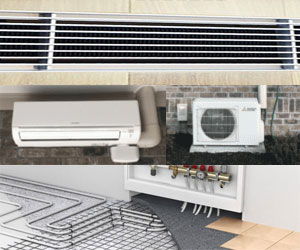 Here we’ve compared the three main types of modern heating systems, forced air heating, ductless mini splits & hydronic heating. We say modern as we haven’t included the good old wood burning stove from days of yore. Modern heating systems come in many options & sizes & are powered by various energy sources, namely oil, gas, electric & solar. Some are stand alone heating systems while some combine heating with air conditioning. While forced air is by far the most common, mini splits & hydronic heating are more recent innovations that offer increased efficiency.
Here we’ve compared the three main types of modern heating systems, forced air heating, ductless mini splits & hydronic heating. We say modern as we haven’t included the good old wood burning stove from days of yore. Modern heating systems come in many options & sizes & are powered by various energy sources, namely oil, gas, electric & solar. Some are stand alone heating systems while some combine heating with air conditioning. While forced air is by far the most common, mini splits & hydronic heating are more recent innovations that offer increased efficiency.
Forced Air Heating
Forced air heating systems heat air with a furnace & an air handler distributes the air through ductwork & out air vents. Furnaces can be powered by gas, oil, electric or solar. If the system is combined with air conditioning it also requires a large outdoor unit called a condenser.
Pros
• Can combine heating & air conditioning in the same system
• The least costly to install, especially for a system with both heat & ac
• Heats & cools rooms quickly
• Can include a filtration system to improve air quality
• Can include a humidifier in the system to control humidity
Cons
• The most costly to run, not as efficient as hydronic or mini split, though modern systems are reasonably efficient
• Warmth isn’t very evenly distributed, there can be hot & cold spots and floors tend to remain cold, especially tile.
• Central systems (running off a single furnace) have one thermostat only. Although you can adjust the vents in each room the system isn’t capable of having thermostats in each room. This also makes it less efficient because you have to heat the whole house, whereas with mini splits & hydronic you can heat rooms individually.
• Ductwork must be tightly sealed as leaks in ductwork can contribute to heat loss
• Air quality can be made worse if filters aren’t changed regularly, dust & allergens can be blown around
• Can be noisy when air is blowing & possibly there can be pinging sounds in the ductwork from thermal expansion. Ductwork can also carry sound from any room throughout the house
• System must be properly sized to operate efficiently
• Will not operate off grid or during power outages unless the furnace & blower are both non electric.
Ductless Mini Splits
Mini Split systems, also known as heat pumps or ductless ac, pass heat from an outdoor unit through refrigeration lines to an indoor air handler. Typically each room has an air handler. Air handlers each have a thermostat allowing the room or zone to be heated or cooled independently. Most units handle two or three air handlers (or zones).
Pros
• No ductwork needed, allowing mini splits to be easily added to any room where ductwork is not available or is impractical, for example additions & garage conversions.
• More efficient & less costly to run than forced air, but not more efficient than hydronic.
• Can combine heating and air conditioning in a single unit
• Heats room fast
Cons
• Costly to install, about 30% more than forced air, almost as costly as hydronic but maybe 10% less
• Not ideal aesthetically because air blowers must be placed on walls. In some cases the refrigeration line tubing may be difficult to hide. Some models do offer ceiling cassettes to hide the unit in the ceiling, though it may require some ductwork in the ceiling.
• Hot & cold spots can also be an issue as with forced air. Centrally placed four sided ceiling cassettes can improve distribution of heat.
• Will not operate off grid or during power outage unless it’s connected to solar
• System must be properly sized to operate efficiently
• Doesn’t have the option to filter or humidify air
• Not very effective when temperatures reach below zero
• Some units may produce a hum
Hydronic Floor Heating (Radiant Heat)
Hydronic systems heat the floor by pumping hot water from a boiler to tubing beneath the floor. Heat rises up & heats the room. The boiler can be powered by gas, oil, electric or solar. Hydronic heating tubes can also be placed in walls, though floors is more common. Some radiant heat systems produce heat through electric cables rather than heated water. Such systems are more suitable for individual rooms due to being less efficient. Hydronic heating, the most efficient type of system, is ideal for whole house heating. Hydronic floor heating is considered somewhat of a luxury because it’s more expensive to install & is considered to provide the most comfort.
Pros
• Most efficient, saves heating costs 30-50% compared to forced air & mini split; works well for whole house heating unlike electric floor heating which is too expensive to run for a whole house heating system
• Can have thermostats in each room & control the temperature for each room individually which also contributes to lower heating costs by not having to heat vacant rooms
• The most comfortable & high end, evenly distributes heat throughout rooms; with other systems temperature may vary throughout the room
• Keeps floors warm, other systems tend to leave floors cold because warm air rises causing much of the warm to stay closer to the ceiling
• No noise at all, quietly warms the room
• Doesn’t blow dust & allergens around
• Can operate off grid or during power outages if the boiler isn’t electric (gas, oil or solar)
• May qualify for tax break or utility company rebate due to efficiency
Cons
• Can cost about 40% more to install (though costs can eventually be returned through monthly savings on energy bills)
• Doesn’t combine with air conditioning in a single system, separate ac would be required which could further add to setup costs
• More difficult to repair if ever there’s a leak beneath the floor
• Can make air dry in dry climates, without ability to add humidity to the system, would need to use room humidifier
• Can take longer to heat a room than forced air or mini split








